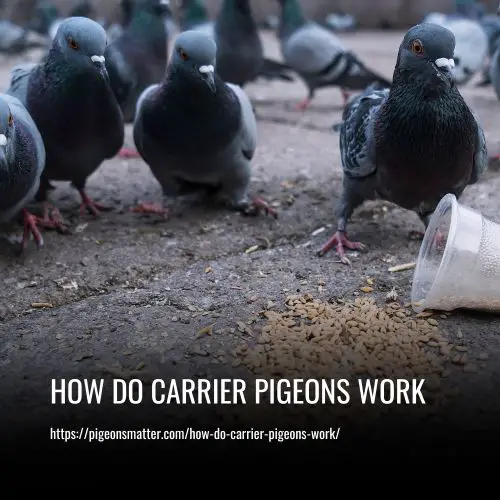Carrier pigeons are used to transport messages over long distances. They are taken to a specific location and released. The pigeons then fly back to their home, carrying a small message in a tube attached to their leg. This is possible because pigeons have natural homing abilities and can find their way back to their home. They have been used as messengers in various parts of the world.

Reasons Why Pigeons Became Important Mail Carriers
Historically, couriers who relied on horseback or foot transportation were known to be unreliable, prone to mishaps, delays, and lacking in confidentiality. A more dependable and faster system was needed, leading to the rise of pigeon delivery. Pigeons were preferred for their docility, ease of capture, quick reproduction, and reliability.
Homing pigeons were created through the selective breeding of rock pigeons, resulting in superior navigational abilities. Above all else, pigeons have a well-deserved reputation for being exceptional navigators, making them the ideal choice for speedy and efficient deliveries.
1. Pigeons Are The Best Bird For The Task
Pigeons were the favored bird for delivering messages for several reasons. They are known for being relatively calm and easy to handle, making them ideal for training. Additionally, they are typically easy to catch, making it simple to transport them to different locations.
However, the most significant reason for their popularity is their exceptional sense of direction. Pigeons are renowned for their ability to navigate back to their home location from unfamiliar territories, which made them valuable for delivering messages over long distances.
2. They Carry Small Messages
Carrier pigeons have been used for centuries to safely deliver sensitive material. Messages are written on small pieces of paper and secured to the pigeon’s neck or legs. Once released, the pigeon instinctively flies back to its home, often resulting in the timely and undisturbed delivery of messages.
This method of communication has been used for its reliability and security, as it is difficult for others to intercept the message during delivery. Carrier pigeons were especially useful during times of war or when other forms of communication were unavailable or unreliable. Despite the advancements in technology, carrier pigeons remain a viable option for secure message delivery in certain situations.
3. They Must Be Carefully Trained
Training pigeons for message-carrying is a gradual and systematic process that requires patience and dedication. The first step is to take the pigeons away from their nest or loft and release them to fly back. This helps the pigeons to get accustomed to their surroundings and to develop a sense of direction. As the pigeons become more proficient, the trainer gradually increases the distance between the release sites and the pigeons’ homes. This helps the birds to build up their stamina and to navigate their way back from impressive distances.
The training process requires consistency and repetition, as well as careful observation of the pigeons’ behavior and progress. With time and practice, the pigeons will become skilled messengers that can reliably carry messages over long distances.
4. They Follow Roads
Pigeons have a variety of methods for finding their way home, including following landmarks and manmade roads. Over short distances, they may rely solely on these methods. Researchers have observed that pigeons tend to follow roads and highways, even if it means taking a longer route.
They are so committed to this method that they will even fly around roundabouts to ensure they take the correct out-road to lead them home. Understanding how pigeons navigate can help us better appreciate their remarkable abilities.
5. They Use Their Noses
Research has shown that pigeons use their sense of smell in navigation. In an experiment where the nasal nerves of pigeons were snipped, the birds were unable to find their way home, indicating that smell plays a crucial role in their navigation.
However, it’s unlikely that pigeons solely rely on their sense of smell to navigate. Instead, it’s believed that they learn the scents of their home area through wind patterns and use that information to travel within unfamiliar territory.
6. They Possess Internal Compasses
Pigeons have an innate ability to navigate using their internal magnetic “compasses.” These compasses are believed to be located around the nose and eyes and help the pigeon calculate the Earth’s magnetic fields. Other animals, such as rainbow trout and chickens, also possess similar compasses to aid in navigation.
By using their magnetic compasses, pigeons can orient themselves and map out routes home. This ability is crucial for their survival and allows them to travel long distances with precision. Understanding how these compasses work can help us better understand animal navigation and behavior.
7. They Have Superior Magnetoreception Skills
Pigeons are known for their remarkable magnetoreception skills, which allow them to navigate using the Earth’s magnetic fields. This ability is known as magnetoreception and is believed to work in conjunction with their internal compasses.
There is ample evidence to support this theory. Large losses of pigeons often coincide with solar storms that can disrupt the Earth’s magnetic field, suggesting that the birds rely on this field for navigation. Pigeons’ magnetoreception skills are truly impressive and are just one of the many fascinating aspects of these birds.
8. They Make Mental Maps With Sound Waves
Pigeons have incredible hearing abilities that allow them to navigate their surroundings with precision. They can detect low-frequency waves that emanate from the Earth, which is thought to aid in their ability to create mental maps of their surroundings.
Experts believe that pigeons use these mental maps to guide them when they are flying, helping them find their way home. This theory suggests that pigeons rely on their hearing to navigate, which is why they are so successful at finding their way even when they are far from home.
9. They Appear Throughout History
Although carrier pigeons are not commonly used today, their impact on history is significant. This concept dates back to ancient Greece, where pigeons were released to announce important events. Genghis Khan implemented a communication system using pigeons to disseminate messages across his empire.
During World War I and World War II, carrier pigeons were used on raid planes, and many birds received medals of honor for their bravery in delivering messages that saved lives. The legacy of carrier pigeons is a testament to their intelligence and ability to serve as an effective means of communication.
10. Using their Perception
Pigeons have a remarkable ability to navigate and find their way home from short distances. They rely on their keen eyesight and other cues to pinpoint their familiar setting. Landmarks and man-made roadways are often used as a guide to lead them back to their home.
Are Pigeons Always Successful To Carry Messages
Despite their impressive navigational abilities, pigeons can still become lost for a variety of reasons. Predators and unfavorable weather conditions can disrupt their flight path, while even supersonic jets can interfere with the sound waves that they use for guidance. It’s important to be aware of these potential factors and take steps to minimize their impact on pigeons’ ability to navigate.
Top Tips For Managing Your Carrier Pigeons
Carrier pigeons played a crucial role in transmitting messages during the First World War, particularly in situations where other means of communication were unavailable. These birds were used on land, sea, and air and could travel up to 100 miles to deliver crucial messages back to headquarters and bases.
Training and caring for pigeons were challenging tasks, and the British Expeditionary Force provided guidelines for the men working in the Carrier Pigeon Service. Here are some of the top tips from the ‘Carrier Pigeons in War’ pamphlet issued in March 1918:
1. Care for Your Pigeons
It’s essential to provide your pigeons with the best possible care, including clean water, good food, and a comfortable living environment. Keep their loft clean and free from pests to promote their health and well-being.
2. Train Your Pigeons
Training your pigeons is essential to ensure they can deliver messages quickly and efficiently. Start with short distances and gradually increase the distance as they become more experienced.
3. Use Proper Equipment
Make sure you have the right equipment, including pigeon carriers and message tubes, to ensure your pigeons can deliver messages safely and securely.
4. Keep Records
Keeping records of your pigeons’ health, training, and message deliveries is crucial to their success. It will also help you identify any issues that need to be addressed.
5. Be Prepared
Always be prepared for any situation, including bad weather or unexpected delays. Have backup pigeons available in case of emergencies, and ensure they are trained and ready to deliver messages when needed.
By following these guidelines, carrier pigeon service men could ensure that their feathered messengers were well taken care of and ready to deliver important messages during times of war.
FAQs
Carrier pigeons have an exceptional ability to navigate and find their way back to their home loft. They use their keen sense of sight, as well as their ability to detect the Earth’s magnetic field and other environmental cues to guide them.
Messages are typically attached to the carrier pigeon’s leg using a small, lightweight capsule or tube. The message is tightly rolled up and inserted into the capsule, ensuring that it stays secure during the pigeon’s flight.
Carrier pigeons are capable of flying long distances, with some pigeons having been known to travel over 1,000 kilometers in a single journey. Their endurance and navigational abilities make them reliable messengers.
Carrier pigeons can fly at impressive speeds, reaching an average of 50-60 mph during their flights. This allows them to cover long distances in a relatively short amount of time.
While carrier pigeons are no longer used for military or commercial purposes, some hobbyists and enthusiasts still train and utilize carrier pigeons for sport and recreational activities, such as pigeon racing.
When a carrier pigeon arrives at its destination, it will typically peck at a designated spot or make its presence known, signaling to its handler that it has completed its journey and delivered its message.
Conclusion
Carrier pigeons may seem like a thing of the past, but their ability to navigate and deliver messages with incredible accuracy is still something to marvel at. From their keen sense of direction to their impressive homing abilities, carrier pigeons have been an important part of human communication for centuries. Who knows, maybe one day we’ll even see them make a comeback in the age of technology.


